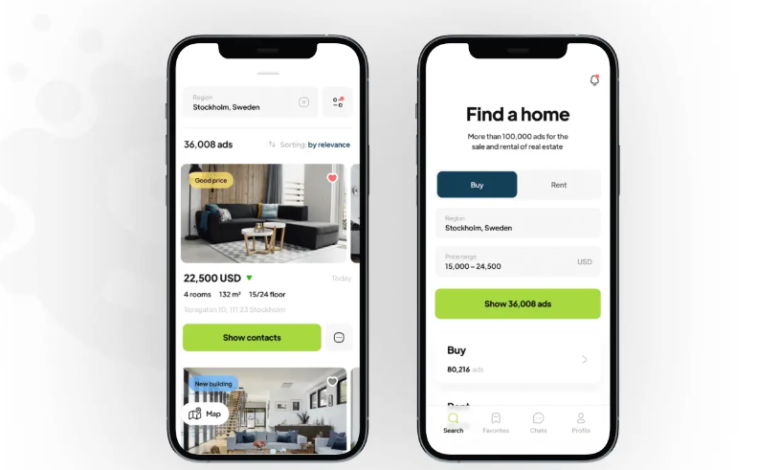What is Property Listing App Laravell ?

Property Listing App Laravell have become essential tools for real estate agents, property owners, and potential buyers in the digital age. These apps provide a convenient platform for listing and searching properties, making the buying and selling process more efficient and accessible.
One of the most popular and widely used property listing apps is Laravell. Developed by Taylor Otwell in 2011, Laravell is an open-source PHP web framework that follows the model-view-controller (MVC) architectural pattern. It is built on top of the Symfony web application framework and provides a robust set of features for developing modern web applications.
Laravell has gained significant popularity among developers due to its elegant syntax, powerful tools, and ease of use. It offers a streamlined development process with its pre-built components and libraries, allowing developers to focus on creating unique features rather than spending time on repetitive tasks.
So what makes Laravell stand out as a property listing app? Let’s explore some of its key features:
MVC Architecture:
As mentioned earlier, Laravell follows the MVC pattern, which separates business logic from presentation layers. This means that developers can easily modify or update one part of the app without affecting other parts. In terms of property listings apps, this allows for seamless updates to be made to properties without disrupting user experience.
What is Laravel and why is it used for property listing apps?
Laravel is a widely used open-source PHP web framework that has gained immense popularity in the development community. It offers an elegant and robust platform for building dynamic web applications, including property listing apps. In this section, we will dive into what exactly Laravel is and why it is the preferred choice for property listing apps.
What is Laravel?
Laravel was first introduced in 2011 by Taylor Otwell and has since evolved into a mature and feature-rich framework. It follows the Model-View-Controller (MVC) architectural pattern, making it easy to develop well-organized web applications. Its powerful features, such as routing, caching, authentication, and database management, make it a developer’s favorite.
Why use Laravel for Property Listing Apps?
- Efficient Development Process
Laravel’s main goal is to simplify the development process by providing tools that developers need to build complex applications quickly. Using its command-line interface (CLI), developers can create project structures, manage dependencies with Composer, run tests, migrate databases, and much more. This results in faster development time while maintaining high-quality standards. - Robust Authentication System
Property listing apps require user authentication to ensure that only registered users can access certain features like creating listings or contacting other users. With Laravel’s built-in authentication system, developers can easily implement user registration and login functionality without having to write extensive code from scratch.
Features of Property Listing App Laravell
Laravell is a popular open-source PHP web framework that has gained immense popularity in recent years. It offers a robust and elegant development environment, making it the preferred choice for many developers. One of the many use cases for Laravell is creating property listing apps.
A property listing app built on Laravell is a powerful tool designed to simplify the process of buying, selling or renting properties. It provides real estate agents and property owners with a platform to showcase their properties to potential buyers or tenants.
So, what makes a property listing app built on Laravell stand out from other similar applications? Let’s delve into some of its key features:
- User-friendly interface:
The first thing that attracts users to any application is its user interface. A property listing app built on Laravell comes with an intuitive and visually appealing interface that makes it easy for users to navigate through the various features and functionalities. - Property Search:
One of the primary features of any property listing app is its search functionality. With Laravell, developers can easily incorporate advanced search options such as location-based search, filters for price range, number of bedrooms/bathrooms, amenities, etc., making it easier for users to find their desired property quickly. - Property Listing Management:
Laravell allows developers to create dynamic forms for adding or editing listings with ease. This feature enables agents or property owners to manage their listings efficiently by adding essential details such as photos, descriptions, and pricing information.
Key Benefits of Using Laravel for a Property Listing App
The user-friendly interface is a crucial aspect of any property listing app, and Laravel is no exception. A user-friendly interface refers to the design and layout of the app that allows users to easily navigate and interact with its features.
One of the key benefits of using Laravel for a property listing app is its intuitive and well-organized interface. The clean and modern design makes it easy for users to understand the app’s functionality without much guidance. This means that even individuals with limited technical knowledge can use the app without any difficulties.
The first thing that users will notice when accessing a property listing app built with Laravel is its visually appealing interface. The developers can customize the appearance according to their brand or theme, making it more attractive to potential customers. With Laravel’s extensive library of front-end templates, developers have endless options for creating an aesthetically pleasing interface.
The navigation system in a Laravel-powered property listing app is also designed to be simple and straightforward. Users can easily browse through different listings, filter results based on their preferences, and access all essential features with just a few clicks or taps.
Moreover, one of the notable features of Laravel is its responsive design. This means that the app automatically adjusts its layout according to the screen size of the device being used. Whether accessed from a desktop computer or a mobile device, users will enjoy a seamless experience without compromising functionality or visual appeal.
Advanced search options
The advanced search options feature in property listing app laravell is a powerful tool that allows users to refine their search for properties based on specific criteria. This feature provides a more targeted and efficient way for users to find the perfect property that meets their needs and preferences.
One of the main benefits of using advanced search options is the ability to filter by location. Users can narrow down their search results by selecting specific cities, neighborhoods, or even zip codes. This is especially useful for those who have a preferred area they want to live in or are looking for properties within a certain radius of their workplace.
Additionally, users can also filter by property type, such as apartments, houses, condos, or land. This helps to eliminate any irrelevant properties from the search results and saves time for both buyers and sellers. For example, if a user is only interested in purchasing a house but keeps getting listings for apartments, they can easily filter out those results with just one click.
Moreover, advanced search options allow users to specify their desired price range. This ensures that only properties within their budget will be displayed in the search results. Users can also set minimum and maximum values to further refine their price range and avoid any unnecessary back-and-forth negotiations with sellers.
Another useful feature of advanced search options is the ability to filter by amenities. Users can select which amenities they consider essential when searching for a property, such as parking space availability, number of bedrooms or bathrooms, pool access, etc. This ensures that the listed
Property management tools
Property management tools are an essential component of any property listing app built on the Laravel framework. These tools provide users with a wide range of functionalities that make managing properties more efficient and streamlined. Whether you are a property manager, landlord, or real estate agent, these tools can help you stay organized and save time while managing your listings.
One of the most important features of property management tools is the ability to create and manage listings within the app. With just a few clicks, users can add new properties to their portfolio and easily update existing ones. This eliminates the need for manual data entry and reduces the chances of human error.
Additionally, these tools offer advanced search capabilities that allow users to filter through their listings based on various criteria such as location, price range, type of property, etc. This makes it easier for potential tenants or buyers to find what they are looking for quickly.
Another useful feature is the ability to collect and store important documents related to each property. Users can upload contracts, lease agreements, inspection reports, and other relevant documents directly into the app. This not only keeps all information in one place but also ensures that it is easily accessible whenever needed.
In addition to managing properties themselves, these tools also facilitate communication between landlords/property managers and tenants/buyers. Users can send messages or notifications directly through the app regarding rental payments, maintenance requests, or general inquiries. This streamlines communication processes and helps maintain a professional relationship with clients.
Payment integration
Payment integration is an essential aspect of any property listing app and Laravel makes it easier than ever before. In today’s digital age, most transactions are done online, making payment integration a crucial feature for any app that involves buying or selling properties.
With Laravel, developers can seamlessly integrate different payment options into their property listing app. This allows users to make secure and convenient payments directly through the app, without having to switch between multiple platforms. The framework supports various popular payment gateways such as PayPal, Stripe, Braintree, and many more.
One of the significant advantages of using Laravel for payment integration is its robust security features. The framework has built-in protection against common threats like SQL injections and cross-site scripting (XSS), ensuring that all transactions made through the app are safe and secure. It also offers features like CSRF protection and data encryption to further enhance the security of user data.
Laravel’s elegant syntax makes it easy for developers to implement complex payment processes quickly. Its built-in tools like Cashier allow for seamless subscription billing management, making it ideal for apps that offer recurring services or subscriptions. With Cashier, developers can easily set up plans with different intervals and billing cycles while handling cancellations and renewals effortlessly.
Furthermore, Laravel comes with extensive documentation on how to integrate specific payment gateways step-by-step. This documentation includes code examples that developers can use as a reference point when implementing payment options in their app.
Communication features
The communication features of a property listing app are crucial for both property owners and potential buyers or renters. These features allow for seamless and efficient communication between all parties involved, making the process of buying or renting a property much easier and faster. In this section, we will discuss some of the key communication features that make Laravel Property Listing App stand out from its competitors.
- Instant Messaging:
One of the most essential communication features in any property listing app is instant messaging. This feature allows users to communicate with each other in real-time, eliminating the need for traditional forms of communication such as phone calls or emails. With instant messaging, users can quickly inquire about a property or negotiate terms without having to wait for responses. - Chatbots:
Another innovative feature found in Laravel Property Listing App is chatbots. These AI-powered virtual assistants can handle basic inquiries and provide information about properties listed on the app. They are available 24/7 and can respond to multiple queries simultaneously, making them an invaluable asset for busy real estate agents. - Video Conferencing:
With video conferencing capabilities integrated into the app, users can conduct virtual property viewings from anywhere at any time. This feature is especially useful for potential buyers or renters who live far away from the property they are interested in. It saves time and resources by eliminating the need to physically visit a property before making a decision.
How does Property Listing App Laravell work?
The Property Listing App Laravell is a powerful and highly customizable platform designed to simplify the process of buying, selling, and renting properties. It utilizes the Laravel framework, which is a popular PHP web application framework known for its elegance, simplicity, and extensive features.
So how exactly does the Property Listing App Laravell work? Let’s take a closer look at its key components and functionalities:
1) User Registration: The first step to using the Property Listing App Laravell is to register as a user. This can be done easily through a simple registration form where users can provide their basic information such as name, email address, and password. Once registered, users will have access to all the features of the app.
2) Property Listings: The core feature of the Property Listing App Laravell is its ability to display property listings in an organized manner. Users can search for properties based on various criteria such as location, price range, type of property (e.g., apartment or house), number of bedrooms/bathrooms, etc. They can also view details about each property including images, descriptions, amenities, and contact information for the seller/renter.
3) User Profiles: Each user has their own profile page where they can manage their personal information and preferences. They can also save their favorite properties for future reference and set up alerts for new listings that match their desired criteria.
Benefits of using Property Listing App Laravell for real estate businesses
The real estate industry is constantly evolving and adapting to new technologies, making it essential for businesses to stay updated in order to thrive. One such technology that has revolutionized the way real estate businesses operate is the property listing app Laravell. This innovative app has gained popularity among real estate professionals for its numerous benefits and features.
Here are some of the key benefits of using Property Listing App Laravell for real estate businesses:
- Efficient Management of Listings: One of the major advantages of using Property Listing App Laravell is its ability to efficiently manage property listings. The app provides a user-friendly interface where agents can easily upload and update property information, including images, videos, and descriptions. This makes it easier for potential buyers or renters to view and compare properties, ultimately leading to faster sales or rentals.
- Centralized Database: Another benefit of using this app is that it offers a centralized database system to store all your listings in one place. This saves real estate professionals from the hassle of managing multiple platforms or databases for different properties. With all data stored securely in one place, agents can easily access and update information anytime, anywhere.
- Advanced Search Filters: Property Listing App Laravell comes equipped with advanced search filters that allow users to refine their search based on specific criteria such as location, price range, number of bedrooms/bathrooms, etc. This not only helps potential buyers/renters find their ideal property quickly but also saves time for agents by providing them with relevant
Case studies: success stories of businesses using Property Listing
Case studies are real-life examples of how businesses have successfully utilized property listing app Laravel to streamline their operations and achieve their goals. These success stories not only showcase the potential of the app but also provide valuable insights for other businesses looking to leverage its benefits.
Let us explore some case studies of businesses that have seen significant growth and success after implementing property listing app Laravel:
ABC Real Estate Agency: This agency specializes in buying, selling, and renting residential properties. Before using Laravel’s property listing app, they struggled with managing a large database of properties and matching them with potential buyers. With the help of this app, they were able to integrate all their listings onto one platform, making it easier for clients to search for properties based on their preferences. The agency saw a 25% increase in customer satisfaction as well as a 20% increase in sales within the first year of using the app.
XYZ Property Management: This company manages multiple rental properties across different locations. They were facing challenges in keeping track of rental payments, maintenance requests, and lease agreements for each property separately. After implementing Laravel’s property listing app, they were able to centralize all this information into one system, making it easier for them to manage everything efficiently. As a result, they reported a 30% decrease in administrative tasks and a 15% increase in occupancy rates.




